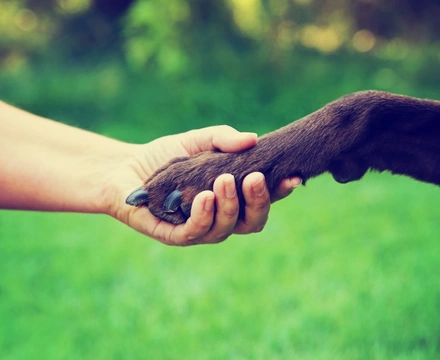
Do dogs have a dominant paw?
We as people tend to have a dominant hand, which we describe as being either right or left handed. This is something that we don’t consciously dictate, and all of us naturally gravitate towards using one hand as our main hand, the one that we use the most and do more with; and being right-handed is most common.
Few people are truly ambidextrous, although we can train ourselves to have a greater level of proficiency with our non-dominant hand, and this is more likely to occur in left-handed people as so much of life is designed for people who are right hand dominant.
Given how widely accepted the concept of “handedness” is in people, it is only natural for dog owners to wonder if dogs also have a dominant paw, and whether your own dog might be right or left-pawed themselves.
In this article we will answer the question of whether or not dogs have a dominant paw, and how this might be expressed. Read on to find out if dogs have a preference for using their right or left paws.
Do dogs exhibit paw preference?
There have been a number of studies into paw dominance in dogs that have determined that most dogs do show a marked preference for using one of their front paws over the other for certain tasks.
When it comes to us humans, working out if someone is right or left handed is largely obvious, because we will look at things such as the hand used to write with, cut food, or otherwise use for tasks that require a high degree of fine motor control.
There are a number of ways to replicate these types of activities in dogs in order to determine paw preference, and one of these is by providing dogs with a stuffed toy that they have to manipulate to get to a treat or paste inside of it, like a Kong. With toys of this type, dogs tend to use one paw to hold the toy in place so that they can get to it, and the paw chosen for this purpose can be determined to be the dominant one.
Most dogs display a marked preference to use the same front paw to do this, although some dogs alternate with both and so may be considered to be ambidextrous, or not having a dominant preferred paw at all.
Interestingly, a study undertaken by researchers at Belfast’s Queen’s University determined that most female dogs exhibit right paw dominance, whilst most male dogs exhibit left paw dominance instead. There may even be a hormonal element to what dictates paw dominance – as demonstrated by this gender divide, and also the fact that paw dominance preference becomes less pronounced or even sometimes disappears entirely after neutering.
Are there any advantages to having a dominant paw?
Dogs will naturally gravitate to using their dominant paw for tasks if they do indeed have a paw preference, because the position and control that this offers them simply makes it easier for your dog to perform the tasks that they need to.
In humans, being left handed can in many ways be seen as a disadvantage, because left handers are in the minority, and many fine motor tasks are better designed for right hand use than left, simply due to the number of members of each respective group. This means that being right handed for people can make life easier, and that left-handed people often face challenges that right handed people don’t, and they have to accommodate for these and work around them (such as by buying left-handed scissors).
However, there is no real advantage to dogs being either right or left handed because the canine world is not one that is reliant on gadgets and tools, and because dogs don’t have elongated finger digits and the same range of movement and control of them that we do.
Finding out if your own dog is right or left pawed
If your dog will shake paws with you, look at the paw they lift out of choice – you will quite possibly find that it is always the same one, although it is worth remembering that not every dog exhibits a paw preference at all.
When your dog is running or playing too, their movement gait will tend to lead off with their dominant paw, and when your dog runs in circles (which is particularly common in many herding dog breeds like the Border collie) they may always circle in the same direction, as dictated by their more dominant paw.
If your dog will lift their paw for a shake with either paw quite happily and if they don’t exhibit a clear preference when gripping things and playing with toys, your dog might not have a dominant paw – or their paw dominance may have become less pronounced after they were neutered.



